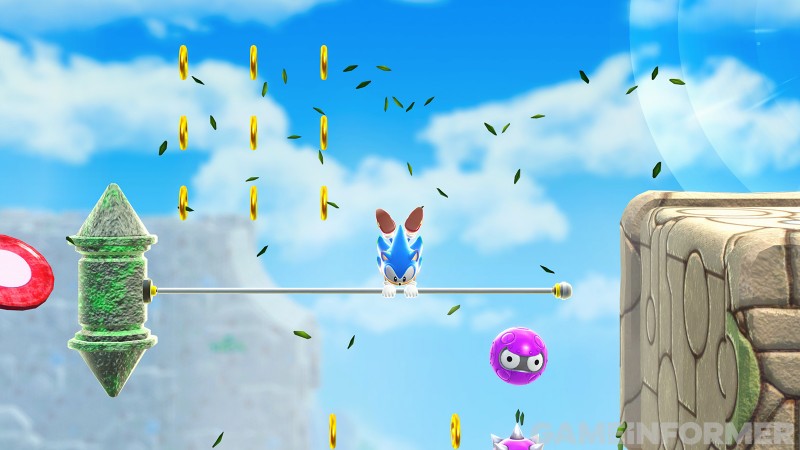
Platform: PlayStation 5, Xbox Series X/S, PlayStation 4, Xbox One, Switch, PC
Publisher: Sega
Developer: Arzest, Sonic Team
Release: 2023
Sonic Superstars aims to give players an experience loyal to those initial Classic Sonic entries on the Genesis. However, unlike past games like Sonic Generations and Sonic Mania, which relied heavily on fan-favorite zones from previous games, Sonic Superstars forges its own path within the Classic Sonic series, delivering all-new stages that still deliver that Classic Sonic feel.
"Well-known stages like Green Hill have made return appearances in many games, but that’s because it was necessary from a story point of view," Sonic Team creative officer Takashi Iizuka says. "This time, Sonic Superstars is set on a brand-new island that hasn’t been seen before, so we planned to have all-new stages from the beginning."
Bridge Island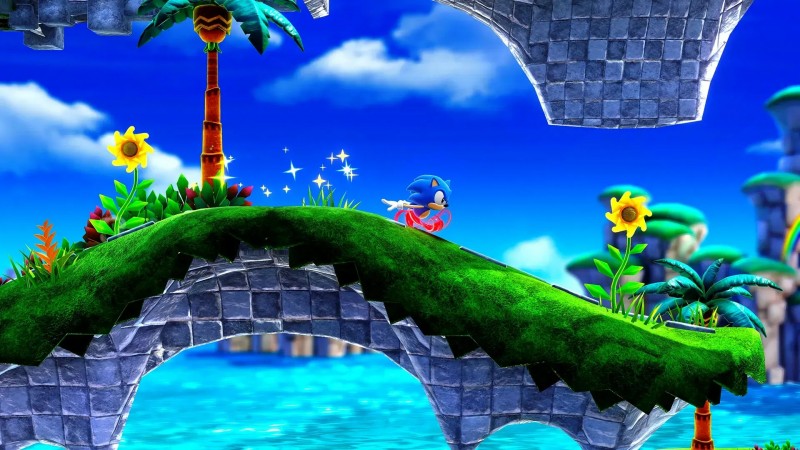
Bridge Island Zone
While you won't find Green Hill Zone or Chemical Plant, the inspiration from past games is clear. Sonic Superstars' first zone, Bridge Island Zone, features similar themes and aesthetics to other starting zones like Green Hill and Emerald Hill, but its design is wholly unique from those. "Bridge Island is that quintessential Sonic-y feel," Iizuka says. "We see the water; it's got that oceanside, beachside, waterfront kind of feel, it's got bright colors, and it's very fun to run around in. It feels very true to the Classic Sonic games. It's our very standard, go-to, 'this-is-a-Sonic-experience' zone."
Bridge Island features several familiar enemies, including Crabmeat, Buzz Bomber, and Chopper, but it also includes new wall-run sections. As I speed through the stage, I'm rewarded for exploration. It's safe to say that the branching-path level design is back in full force in Sonic Superstars. "Multi-pathways are one of the critical elements in designing a Classic Sonic 2D platformer," Iizuka says. When you combine Sonic's speed with side-scrolling, there's no way to avoid sudden falls or places where you can't see where you will land. If you die every time that happens, you won't want to go fast. That's why multi-pathways are essential for level design; even if you fall, there's another route below, or if you play well, you can get to the path above."
Exploration is crucial in these stages, with power-ups and other important points of interest littering each zone. In Bridge Island alone, I find the standard blue shield power-up, a magnet power-up that pulls nearby rings to you, and the always-fun running shoes. I also discover a giant gold ring and a giant blue ring, both of which take me to this game's Special Stages (learn more about Special Stages and Chaos Emeralds in Sonic Superstars here).
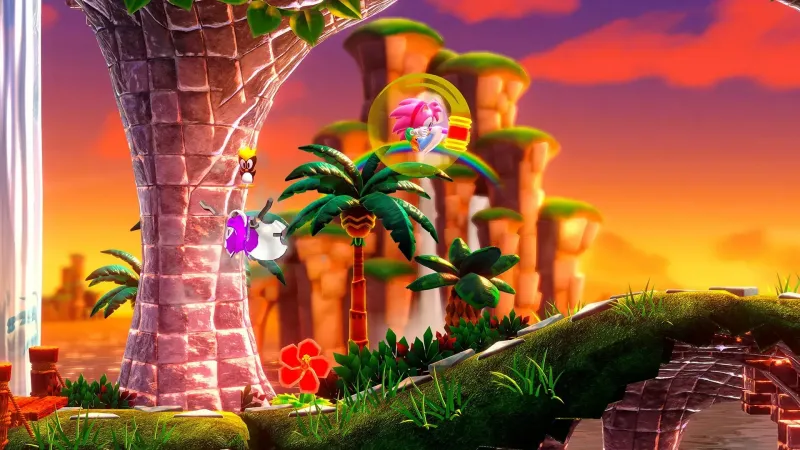
In Act 2, Bridge Island Zone transitions from daytime to sunset, immediately setting this second act apart from its predecessor. "That kind of dynamic change all started with Sonic 3," Iizuka says. "That system was put in place because for Sonic 1 and 2, things were kind of static, and you'd have the same kind of fun and same gameplay in Act 1 just carry over into Act 2. But it was really impactful when we got to Sonic 3 to be able to change the visuals and also change the gameplay style to bring this variation in Act 1 and Act 2, and as a [player], that dynamic shift was very fun. Even as a designer, it was a lot of fun to create these drastic changes in the world, drastic changes in gameplay that created that fun element when you play through from Act 1 to Act 2."
After Act 1's boss battle, which was essentially just a chase sequence involving a giant fish robot, Act 2's boss battle is a proper fight against Eggman in a walker with boxing gloves. Using the Avatar Emerald Power, I make quick work of the evil doctor, but in my excitement to use the power, I neglect to consider that it could be a multi-phase fight. Sure enough, it is, and Eggman abandons the walker and flies toward Sonic with spikes and electricity at his disposal. This form looks intimidating, but nothing a well-timed jump can't handle.
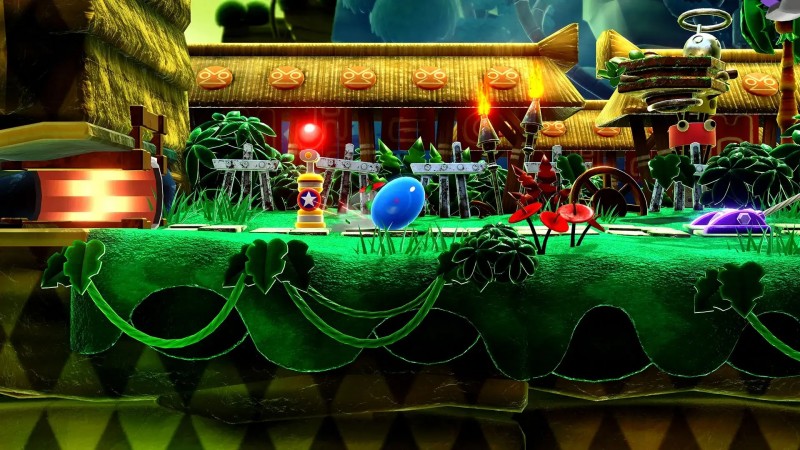
Speed Jungle Zone
After Bridge Island Zone let me get my bearings and familiarize myself with the controls, I used the rest of my hands-on time to see what other locales this game has to offer. Speed Jungle Zone, the other level I had previously played at Summer Game Fest, immediately sets itself apart from the opening Zone.
"For the Sonic games that I create, I have kind of a methodology for how I create things, and I always want the second stage to be this fun, speedy, fast experience," Iizuka says. "So, the first zone is going to be the traditional, standard, very core, 'this-is-a-Sonic-game.' But that second stage, we want to be speedy and fun and fast. Speed Jungle is a good execution on this idea. It's getting people in that fast, fun experience to say, 'Oh wow, yeah, this is a Sonic game. This is what's different about Sonic games!'"
Speed Jungle Zone Act 1 offers vines, both to grind on and to send you flying upward, alongside a mosquito robot boss fight that fires harpoons that stick in the ground so you can run up and attack.
After completing Act 1, I'm given the option to play Act 2, or a different section called "Act Sonic." This alternate act of Speed Jungle Zone lets you run through the stage as Sonic, but with Fang terrorizing you the whole way.
"One other fun thing about Speed Jungle is that it starts introducing the storytelling elements and what's going on in the world as you're playing the game," Iizuka says. "I think a lot of people have this real nostalgic feel for Fang. Some people may not know, but some people may be like, 'Oh my god, Fang's back!' And in the storytelling moments, we get to see Fang attacking Sonic and see that kind of storytelling play out in Speed Jungle."
I don't get any additional context as to what incentivizes you to play this seemingly optional, more challenging stage, which ends in a chase scene where you need to run away from Fang, but it feels like there may be some reason to complete these character-specific levels beyond additional storytelling.
As I move to Act 2, I get a glimpse of the world map, which is reminiscent of Sonic Generations' hub world, where you are running around a 2D plane and selecting your zone. This hub area houses all the zones, as well as the customization shop (with unlockable parts for head, body, arms, legs, accessories, color, pattern, and something called "prototype" using in-game medals) and the ability to swap characters.
I take this opportunity to change to Knuckles for Speed Jungle Act 2. After putting his gliding and climbing abilities to good use, I come to the Act 2 boss: Eggman is back, this time in an impenetrable ball with targeting arms. I can't do any damage to him, but I can trick him into piercing his own contraption – the sweet irony of Knuckles pulling a fast one on Dr. Eggman is not lost on me. After goading Eggman into destroying his own robotic device, The Incredibles style, I'm off to the next zone.
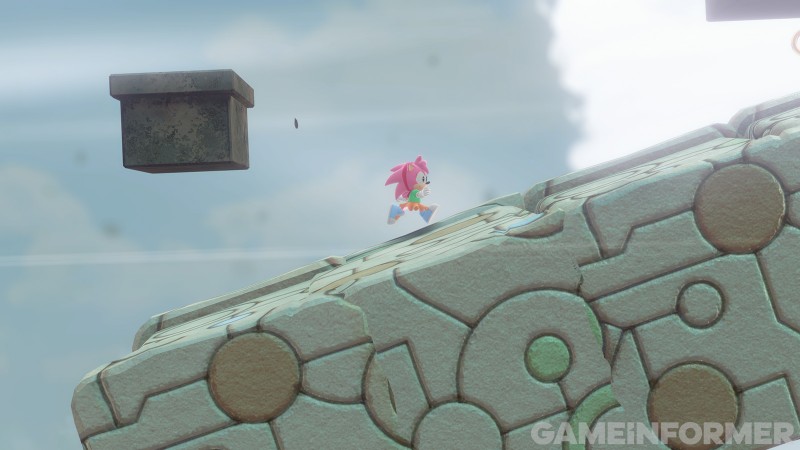
Sky Temple Zone
Just as Bridge Island seems to take cues from other iconic starting zones, Sky Temple Zone seems to mash up inspiration from other levels based in the sky. I pick up potential inspiration pulled from Sky Sanctuary and Flying Battery from Sonic 3 & Knuckles, as well as Windy Valley from Sonic Adventure.
"Zone one and zone two are really there to have that fun, boom, jolt of excitement, but zone three is there as a technical stage," Iizuka says. "We wanted to introduce people to this floating, ancient world. It's floating in midair and we have all these fans and these other contraptions that are blowing things up and keeping things afloat. [You're] able to cross these bridges that are breaking underneath you. [We] really made a zone that's going to be a fun, technical challenge for people who are into that kind of platforming action."
As I platform through this airborne area, I spot badniks I've seen before in stages like Flying Battery and Lava Reef in Sonic 3 & Knuckles, as well as a cloud-shaped enemy. The zone also features platforming sequences with blocks that extend when you step on them, plus a repeated minigame reminiscent of the classic game Breakout, where your character becomes a ball, and you need to aim to break through various bricks.
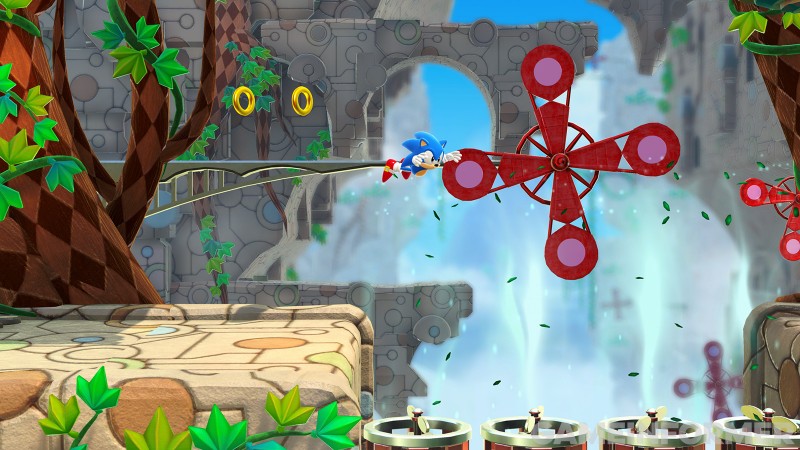
Sky Temple Zone is unique in that Act 1 takes me around nine minutes to complete, but is the only act of the zone. "A lot of the Classic games follow the standard format we have of Act 1 followed by Act 2, Act 1 followed by Act 2, and it kind of creates a rhythm and tempo for the Classic games," Iizuka says. "But the team wanted to break that tempo up and have the gameplay with a different beat. So, some of the zones are going to have maybe three acts, and some of the zones will only have one act. It's changing around the format just a little bit, trying to get a different feel from the players when they're playing through the game."
Near the end of Sky Temple, a massive storm hits, and everything starts floating. This changes the feeling of the stage, similar to how Windy Valley was briefly turned on its head during the tornado sequence. However, in Sky Temple, the storm persists into the boss encounter against Eggman, which is one of the more challenging ones I played; I died a few times here thanks to a shortage of rings in the battle, but the silver lining is I learned Superstars doesn't operate on a traditional lives system.
Eggman smashes the ground, and you need to avoid his projectiles as you fall. From there, you climb up floating blocks until you reach the top to damage him. This repeats, with each ascent becoming trickier. Finally, I put an end to the battle, save the animals he captured, and witness a stage transition to the next zone.
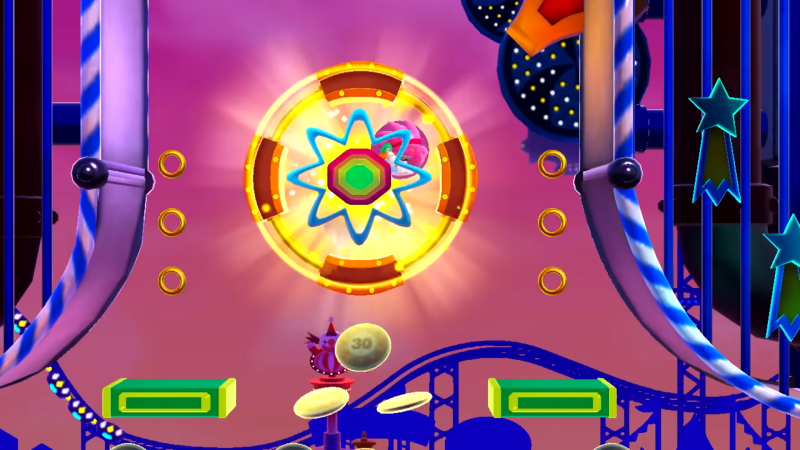
Pinball Carnival Zone
Since the early games, Sonic's journeys have brought him to several pinball-themed stages (and even a pinball-themed game), and that tradition continues through the aptly named Pinball Carnival Zone.
The zone is largely self-explanatory, with large pinball areas and fast sequences with fireworks setting off. In this zone, I encounter badniks based on bats, hermit crabs, and kangaroos.
The Act 1 boss is a clown robot. Here, you need to flip the medallions it places in the battleground to stun it. Dodging its bombs can be a little tricky while you're trying to spin the remaining medallions (it's here that the Bullet Emerald Power comes in handy), but it's a rather straightforward affair.
For Pinball Carnival Zone Act 2, I switch to Tails. He can fly and attack from below, but that doesn't do me much good in this stage, as it transitions to a different feel altogether.
"Pinball Carnival is that real Sonic-y pinball stage that we like putting in the games," Iizuka says. "It's a pinball amusement park. It's this merging of an amusement park with those pinball elements. The first act, it's daytime; it's bright, it's fun, you get to really enjoy getting bounced around having that pinball experience, but then when it becomes nighttime, we see a different tone come through."
Act 2 of this zone transitions the area to nighttime, with a haunted carnival theme emerging and the badniks taking on a ghostly aesthetic.
"We're at an amusement park, but now it's not daytime," Iizuka says. "It's now nighttime, and things are a little bit different. Being able to still have people play that pinball experience but get two kinds of styles out of the pinball feel is what we wanted to do with Pinball Carnival."
This act also adds a sequence where you jump on long platforms that rocket forward like a rollercoaster. Some of these even require you to jump between them using fast reflexes in order to survive.
At the end of Act 2, I take on Eggman once again. This time, he brings a roulette wheel, which he uses to throw bombs my way. After avoiding his attacks, I use the wheel to catapult myself at him, but he protects himself with ghost spirits, similar to his shield at the end of Metropolis Zone in Sonic 2. After timing my attacks correctly, I dispatch him in relatively short order and continue my tour of Sonic Superstars.
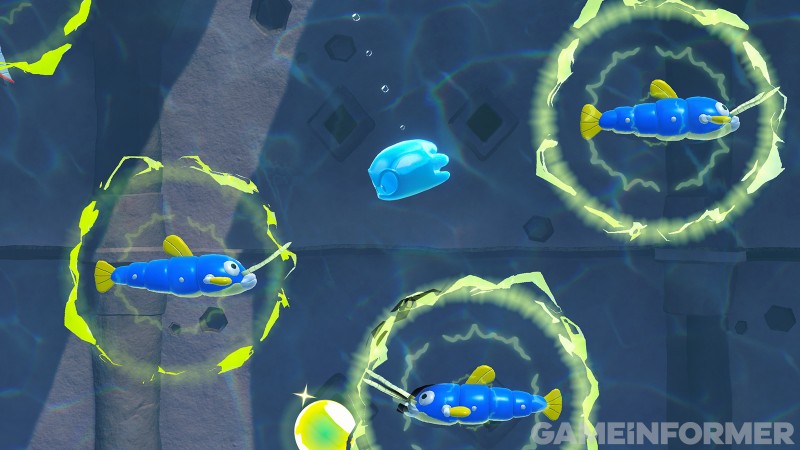
Lagoon City Zone
Lagoon City, with its submerged city ruins and multitude of water slides, awaits me. I'm typically not a fan of water levels, but this might have been my favorite zone of the first half of Sonic Superstars. Even so, I'm glad I brought Tails since he can swim.
Act 1 takes place mostly above water, making for high-speed action set against the watery backdrop. As I navigate this Hydrocity-meets-Aquatic Ruin area, I encounter robots based on waterbugs and underwater worms, plus the cloud robots from Sky Temple make an appearance.
"Lagoon City is the two acts where the Water Emerald Power is going to be super helpful," Iizuka says. "Act 1 and Act 2 have water as the core element in design. When we think about water zones, it's usually, 'Oh, it's going to be a slow tempo. I'm going to be underwater,' but actually, for Act 1, what we want to do is incorporate high speed and water all in the same design. So, you're getting that high-speed Sonic feel, but we're also incorporating water into Lagoon City."
The first act's boss battle features a jellyfish robot that drops badniks, then spears the ground and electrocutes the water. If I time my jump right, I can avoid the energy surge, and the robot will destroy all the badniks it dropped. After defeating the robotic jellyfish, I move on to Act 2.
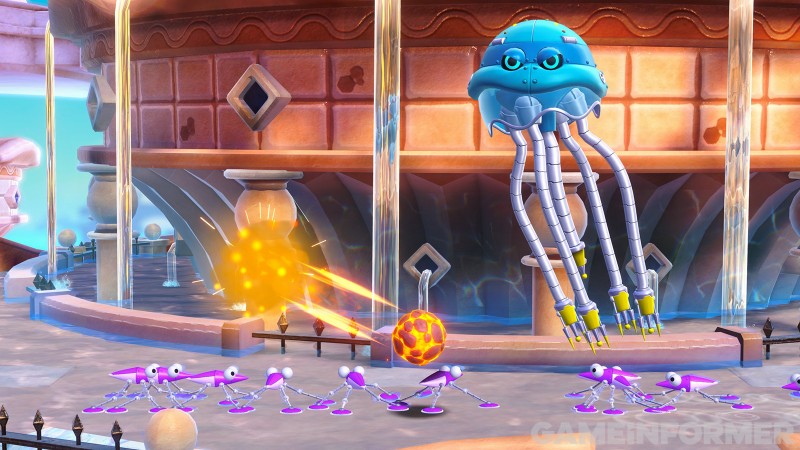
Act 2 includes more fully underwater sequences, for which Tails' ability to swim comes in handy, but if you've been collecting your Chaos Emeralds to this point, there's another way to make this area a bit easier.
"Act 2, that's where you're really going to want to be using the Water Emerald Power just to make sure you can get through and play it however you want to play with that power," Iizuka says. "Using that Water Emerald Power is highly recommended in Lagoon City."
Making it through Act 2 is relatively easy with the two-tailed fox – so much so that I wish I had a chance to play it with a different character just to see how different it feels. En route to the boss, I go through sequences that involve being inside bubbles and navigating small underwater courses to reach new areas.
The Act 2 boss of Lagoon City pits you against Eggman in a crusher machine. After he floods the arena, you need to avoid his drill attacks to damage him. In the first phase, this is a vertical fight, but it transitions to a horizontal battle in the second phase.
The boss battles of Sonic Superstars are among my favorite I've encountered in the series, alongside Sonic 3 & Knuckles. Speaking with Iizuka, there may be a reason why they feel similar in that way. "We thought about the boss fights like Sonic 3, with a mech sub-boss after Act 1 and an Eggman boss after Act 2," he says. "I wrote boss fight specifications for Sonic 3, drawing on that experience to work with Arzest staff on the design."
Before going to the next zone, I take on Episode Amy, a character-specific stage in Lagoon City. This fruit-themed stage lets me use Amy's hammers to blast through huge fruit and fruit-based robots, including a grape robot and a watermelon with a gun. There's also a seal that throws explosive barrels.
Near the end of the stage, I find an armored character who looks lost, in what seems to be another storytelling moment in a character-specific stage. Amy offers to help this creature, and the rest of the stage becomes an escort mission of sorts, with Amy carrying her, unable to attack or double jump. This character is Trip, a creation of Sonic co-creator and original character designer Naoto Ohshima.
I don't have any indication of what role the new character plays in the story, but I don't have long to dwell on that, as my time with Sonic Superstars is coming to a close.
Sand Sanctuary
I take my opportunity to speedrun Sand Sanctuary Zone. Fans of Sonic 3 & Knuckles may draw comparisons to Sandopolis Zone, and it wouldn't be an unfair line to connect. However, throughout the entire stage, a giant snake is present, giving you distinct platforming situations.
"Sand Sanctuary is our desert-themed stage, but from the storytelling perspective, one of the key points is the animals have become jumbo-sized extra large," Iizuka says. "One of the ideas that we had when thinking about what animals could we make really large and put in these zones that would be really cool was a snake. So, we wanted to that that snake motif, or the idea of a snake, and implement that into the design of Sand Sanctuary."
After dodging spike-balls and taking down the Skorps and Vultrons throughout the stage, I clash with Eggman one final time before I relinquish the controller. This time, he's in a drill machine that resembles his Grounder bots. He sends out badniks and burrows underground before popping back up to destroy your platforms (which are situated on quicksand). At that moment, you can attack him, or you can send his badniks flying back at him for free damage. After a few stalled attacks on my part, I finally destroy him.
All I see of the next zone is that it's called Press Factory Zone, but the team turns the game off before I can take in any details, and my hands-on session ends.
Sadly, we don't have a screenshot to share of Sand Sanctuary, but we do have bonus screenshots that show off zones I wasn't able to visit during my playthrough. Check out some exclusive first looks at Press Factory Zone and Golden Capital Zone below.
If this sounds right up your alley, you don't have long to wait. Sonic Superstars is slotted to launch on PlayStation 5, Xbox Series X/S, PlayStation 4, Xbox One, Switch, and PC this fall. For more on Sonic Superstars, be sure to click on the banner below to visit our exclusive coverage hub.
PurchaseSource: Game Informer
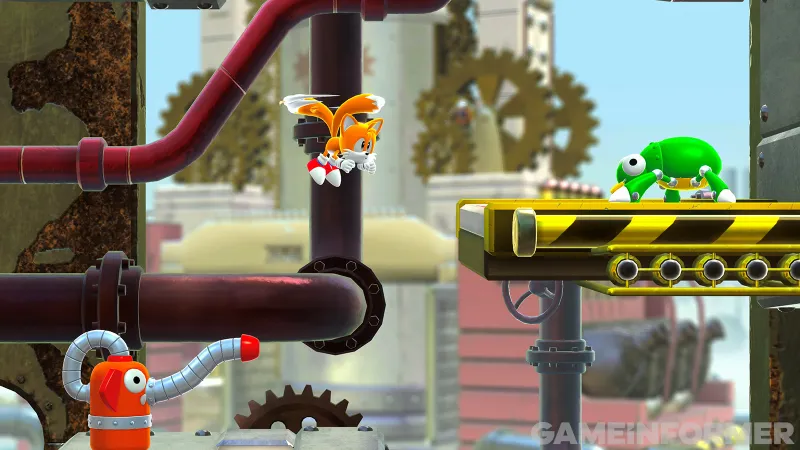
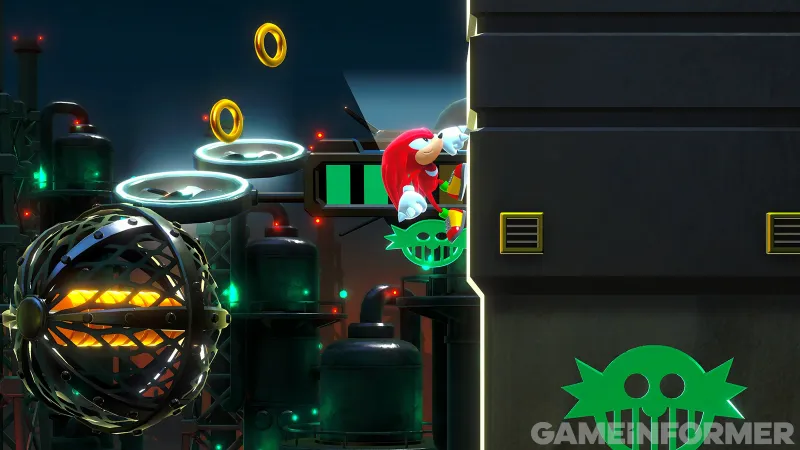
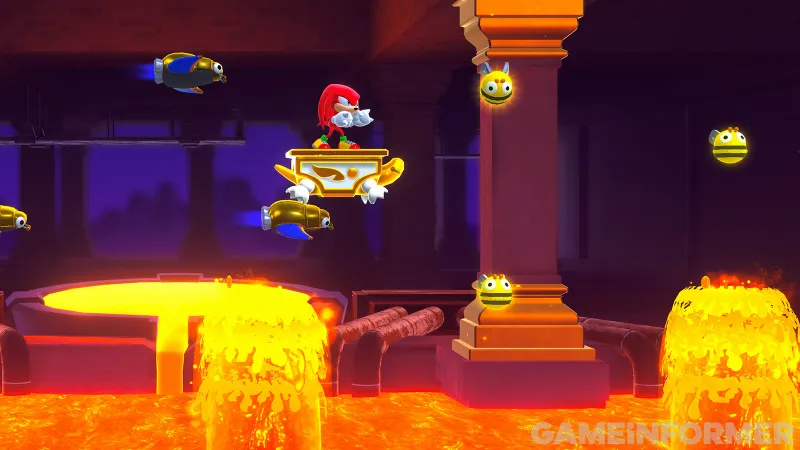
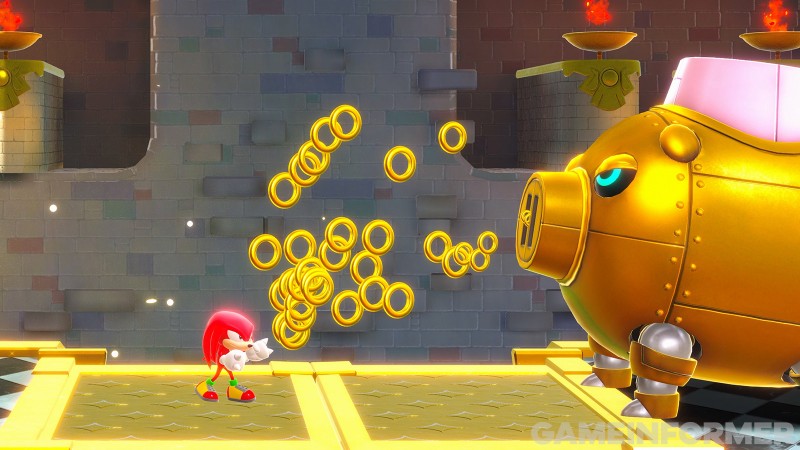
Comments
Post a Comment